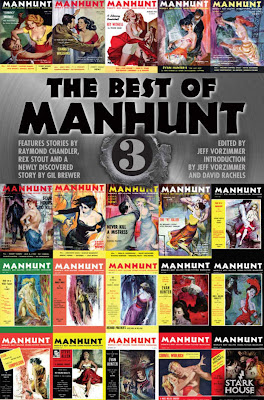By way of background, Sitan authored only three short stories in Manhunt and then disappeared as a writer. According to The Manhunt Companion by Peter Enfantino and Jeff Vorzimmer, Sitan wrote the following stories for Manhunt in three consecutive months during 1954:
“Confession” – July 1954
“Accident” – August 1954
Enfantino and Vorzimmer review all three stories favorably in the guide, but they single out “Confession” as something special. The story of a serial sniper (reviewed below) was selected by editor David C. Cooke for inclusion in his 1955 Best Detective Stories of the Year anthology. Vorzimmer later featured the story in his curated The Best of Manhunt 2 compilation from Stark House Press released in 2020.
I searched far and wide for any indication that Sitan’s work was ever published elsewhere and found nothing. The guy apparently sold three stories to Manhunt and then nothing else, so it’s not crazy to wonder if he was a pseudonym or a house name.
As fun as it would have been to unmask the pen-name of John M. Sitan, a few minutes of internet sleuthing revealed that he was, in fact, a real guy.
John McElroy Sitan was born on May 1, 1925 in Longview, Washington. He served in the U.S. Army during World War 2 from 1943 to 1946. Upon his return to Washington State, he began a 30-year career as a technical writer for Boeing. It was while he was gainfully-employed by Boeing that he decided to do some non-technical writing for the top hardboiled crime digest at the time, Manhunt.
For reasons unclear to me, he never caught the bug to continue his side-hustle as a fiction writer. Instead, he and his wife Hazel focused on getaways to a cabin John built himself on Mount Index and traveling the world on vacations following his retirement. The couple never had children, and John died on November 9, 2012. His limited contributions to the world of hardboiled crime fiction would have been lost to the ages but for a renewed interest in Manhunt spurred on by Stark House Books, Enfantino, Vorzimmer, and Paperback Warrior.
Copies of Manhunt are rare and prohibitively expensive, so mere mortals are forced to leverage modern short story anthologies that reprint the greatest hits from the legendary digest. As such, I’m left with only one resource to read Sitan’s work - the second volume of The Best of Manhunt from Stark House Books, where I found Sitan’s only enduring story, “Confession” from July 1954.
“Confession” is the story of a sniper named John Egan. As the story opens, Egan is pulling the trigger on his scoped and silenced rifle that results in a nurse’s head exploding as the round penetrates her skull on the street below. Egan is not a paid assassin. He’s a factory worker who happens to be a crackerjack shot with a long gun. He’s basically a serial killer before there was a term for such things.
When he takes to the road, the reader gains insight into Egan’s real motivations. Sadly, our modern society has become accustomed to mass killers without conscience. However, when Manhunt published Sitan’s story, it must have been a chilling peek behind the curtain of a remorseless psychopath. The ending was a bit abrupt to me, but it was a satisfying story in line with the dark fiction that made Manhunt great.
Despite his minimal contribution to the catalog of American crime fiction, John M. Sitan was a unique voice who deserves to be remembered. It would be nice to see his other two stories find a modern audience in a future anthology.





















